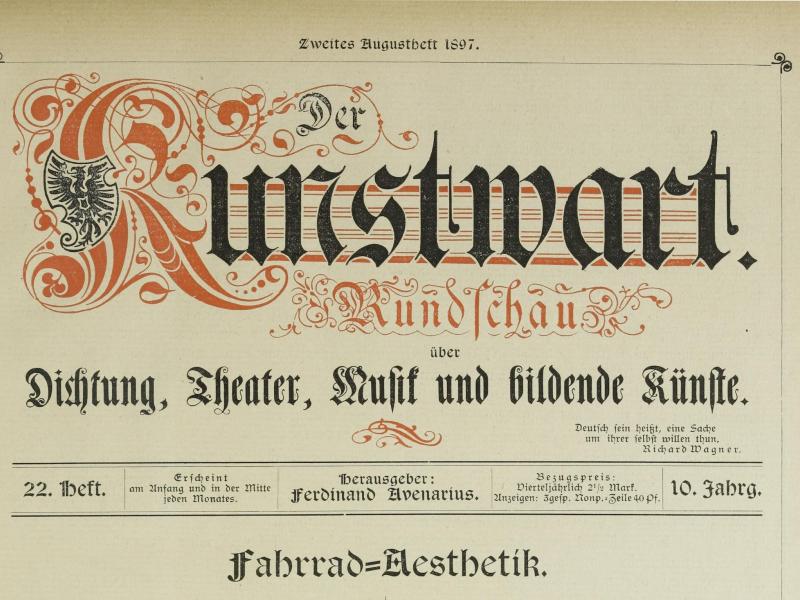Dr. Claudia Bamberg: Movement as a Neo-Romantic Life Practice? The Media of Sports and their Aesthetics in the Vienna Modern Age
Lecture in the context of the conference "Ghostly Technology. Neuromantic reflections on technology and media around 1900".

Date:
23.06.2023Place:
Conference at the Historical Observatory Göttingen, 22 – 24.06.2023.
Lecture 2:30pm – 3:20pm
Categories:
ConferenceContact:
Dr. Claudia BambergDownloads:
The cultural landscape around 1900 was marked by a media revolution, with new forms of perception becoming integrated into everyday life and knowledge cultures. These new forms of perception often interacted with scientific or medical technologies. Cinema challenged subjective patterns of perception, while X-ray images and photographic reproductions shifted the focus of visual culture from "depicting the known" to "making the unknown visible". Phonographs and telephones also introduced new mediation techniques that transformed the dominance of visual culture, which had been shaped by the 19th century.
These changes affected other areas as well, such as increased mobility through the automobile, which shifted places of longing and concepts of foreignness to supposedly more remote places like the Orient, Africa, and outer space. Insights into the physiology of human perception provoked a crisis of subject and language that only unfolded aesthetically on the basis of a revolutionary change in mediality. In short, the culture of perception that emerged at the beginning of the 19th century was put to the test in the decades around 1900.
During this period, a cultural-historical phenomenon emerged that has often been dismissed as epigonal: Neo-Romanticism at the turn of the century reactivated Romantic narrative procedures, which is evident in the revival of countless Romantic authors, especially Novalis, but also in a young literature of "modernity" that explicitly draws on Romantic topoi and representational strategies, such as the works of H. Bahr, M. Maeterlinck, R. Huch, and others.
If one brings both diagnoses together, an astonishing affinity of this neo-romanticism to technological innovations becomes apparent: Multimedia experiments took place around 1900, especially in neo-romantic drama (e.g., Hofmannsthal's ballets, Vollmoeller's pantomimes); ghosts and doppelgangers were given new ontological status in early film (e.g., Ewers' Der Student von Prag); and in prose, fairy-tale princes were worked on with electric drills or undertook good-for-nothing educational journeys by automobile (both O.J. Bierbaum). Whether Goethe's voice was recovered by an artificial larynx on the phonograph (Mynona) or Paul Scheerbart constructed an improbable perpetual motion machine, the narrative handling of media technology was always accompanied in neo-romantic texts by the question of its anthropological dimension. New possibilities of perception provoked a new romanticism, which in its aesthetic strategy was not only technology-savvy but also technology-reflexive.
Thus, a turn emerged that, despite all the media upheaval in the "century of the eye" (Becker 2010), was not found before: Technology and mediality developed their own self-reflexive level. At the same time as neo-romantic texts, films, and visual art, technology historiography and technology philosophy emerged (cf. Maye/Scholz 2015). The recently rediscovered work of Ernst Kapp (cf. Maye/Scholz 2019) was the initiator of this development. Around 1900, philosophy and cultural studies increasingly followed Kapp's questioning of the epistemological and anthropological dimensions of technical media. As a hitherto underestimated multimedia and media-reflexive phenomenon, Neo-Romanticism shaped itself in film, book art, illustration, theater, and literature to appear as a "medium of the medium" analogous to a "poetry of poetry" (F. Schlegel).
The conference aims to explore to what extent neo-romanticism updates and modifies aesthetic models of romanticism to take up innovative media technologies of the turn of the century and reflect them aesthetically. The goal is to open up a corpus of texts, films, images, and forms that do not position themselves in a media-averse or media-critical way but rather conceive of media-technological innovation as a positive epistemic opening and explore its anthropological implications.

